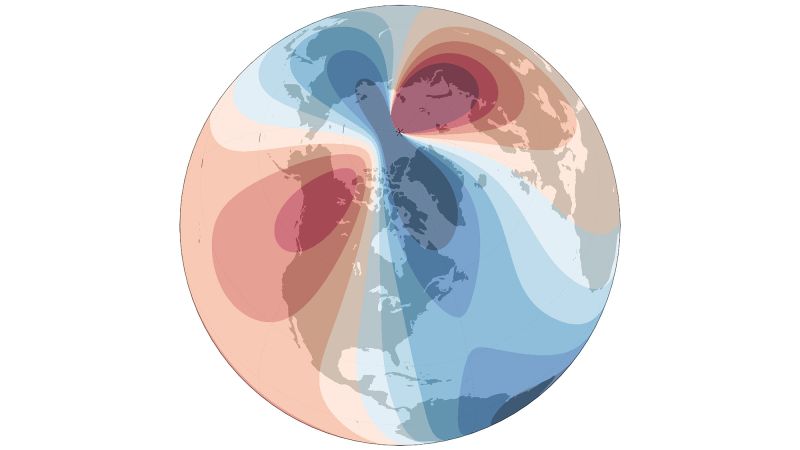In the ever-evolving field of navigation, a new development has emerged that could significantly impact how users of GPS technology find their way. Scientists have unveiled a fresh model for tracking the position of the magnetic north pole, illustrating that it has shifted closer to Siberia over the past five years and continues its drift toward Russia. This information is particularly relevant for individuals relying on smartphones and other devices that utilize GPS for navigation.
The distinction between the geographic North Pole and the magnetic north pole is crucial. The geographic North Pole is a fixed point marking the northernmost part of Earth, where all longitudinal lines converge. In contrast, the magnetic north pole’s location fluctuates due to the dynamic nature of Earth’s magnetic field, which is influenced by the molten metals churning within the Earth’s core. This perpetual motion has resulted in dramatic changes to the magnetic north’s position over recent decades, including inexplicable accelerated movements and subsequent slowdowns that scientists are still trying to comprehend.
The World Magnetic Model (WMM), developed by the British Geological Survey and the National Oceanic and Atmospheric Administration (NOAA), plays an essential role in how global positioning systems (GPS) operate. Established in 1990, the WMM establishes the magnetic north pole’s current position and forecasts its future drift based on historical data. To maintain accurate GPS navigation, researchers conduct updates every five years. Thanks to these revisions, GPS systems can correct positional errors and improve user experience.
Dr. Arnaud Chulliat, a senior research scientist at the University of Colorado, Boulder, and NOAA, emphasizes the necessity of timely updates: “The longer you wait to update the model, the larger the error becomes.” This statement underscores how critical it is for various sectors—particularly aviation and military operations that rely heavily on precise navigation—to have access to the latest data. In fact, the latest model revision, released on December 17, includes both a standard and a high-resolution model, the former being sufficient for most everyday users of GPS devices.
While major airlines and NATO military operations will benefit from upgrading their navigation systems, individual users typically won’t need to conduct separate upgrades. Dr. William Brown, a geophysicist with the British Geological Survey, likens the process to updating an app on a smartphone—changes are important but may not require the purchase of new hardware. The accuracy of the updated model helps confirm earlier predictions made about the magnetic north’s position by 2025.
The necessity of iteration in monitoring the magnetic north includes understanding why it doesn’t remain static. The geographic North Pole itself, located at the center of the Arctic Ocean, remains fixed; conversely, the magnetic north pole’s position is dictated by the fluid dynamics occurring deep within the Earth. Its discovery occurred in 1831 when British explorer Sir James Clark Ross located it in northern Canada, but it has since been drifting toward Russia. Data show that the pole shifts roughly 75 miles daily in an elliptical manner, showcasing the instability of its position.
Recent updates reveal an increased velocity in the magnetic north’s movements. Historically, the pace of drift was around ten kilometers—a mere six miles—per year. However, since the early 1990s, the pole’s drift has accelerated frighteningly, reaching up to 55 kilometers, or close to 34 miles, annually. Following this rate of movement, significant adjustments to the WMM became necessary around 2019 due to the discrepancies between observed and predicted positions.
As scientists continue to monitor these shifts closely, predictions suggest that the drift toward Russia may slow down, though uncertainties linger. Brown and his fellow researchers remain vigilant in studying the magnetic field’s behavior, exploring how it may change over time. With past records indicating that Earth’s magnetic field has reversed its polarity multiple times, the potential effects of a magnetic flip could drastically alter various biological and technological systems on our planet.
From migratory animals relying on the magnetic field for navigation to radio communications and satellite functionalities, a drastic change in the magnetic field would prompt substantial repercussions. While Earth has undergone magnetic reversals for millions of years, navigating modern technology through such an event would present a unique set of challenges never witnessed before.
Mindy Weisberger, a science writer known for her contributions to Live Science and Scientific American, deftly synthesizes ongoing developments in our understanding of Earth’s magnetic dynamics, pushing us to reflect on the historical precedent while considering future implications in navigating both literally and technologically. The continual work done by scientists in this field remains critical not only for navigation accuracy but also for safeguarding life on a planet ever influenced by its shifting magnetic landscape.











